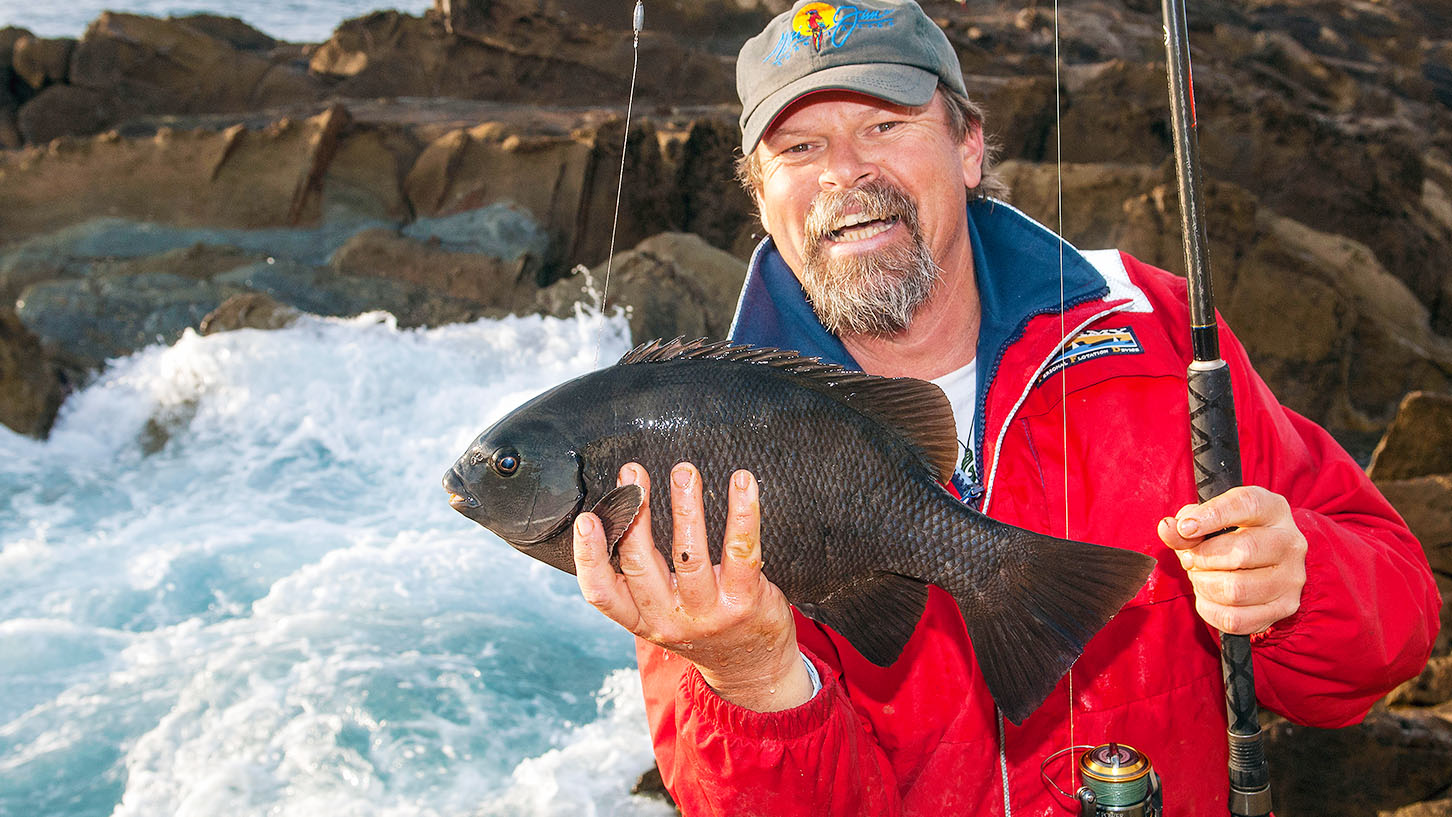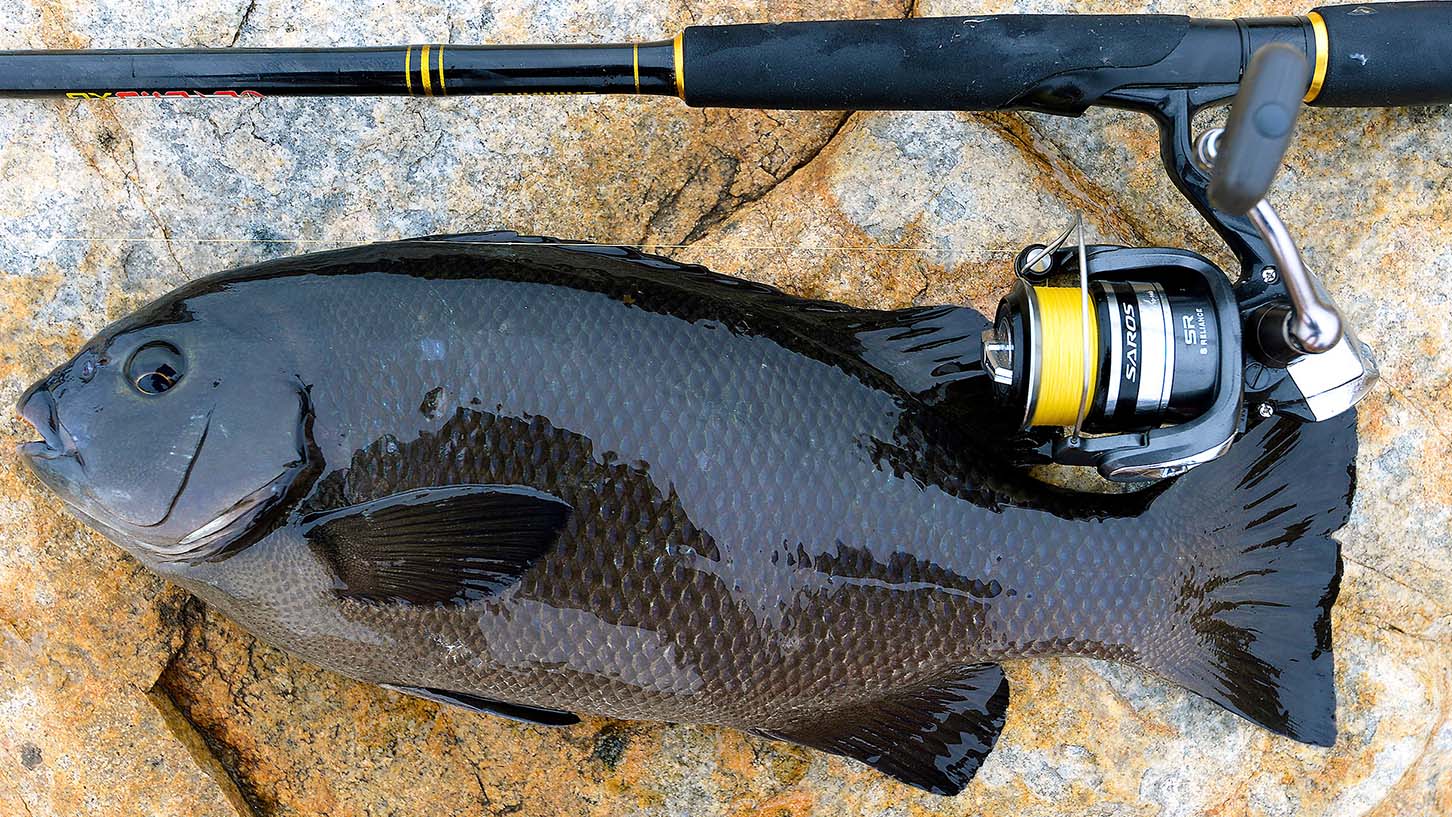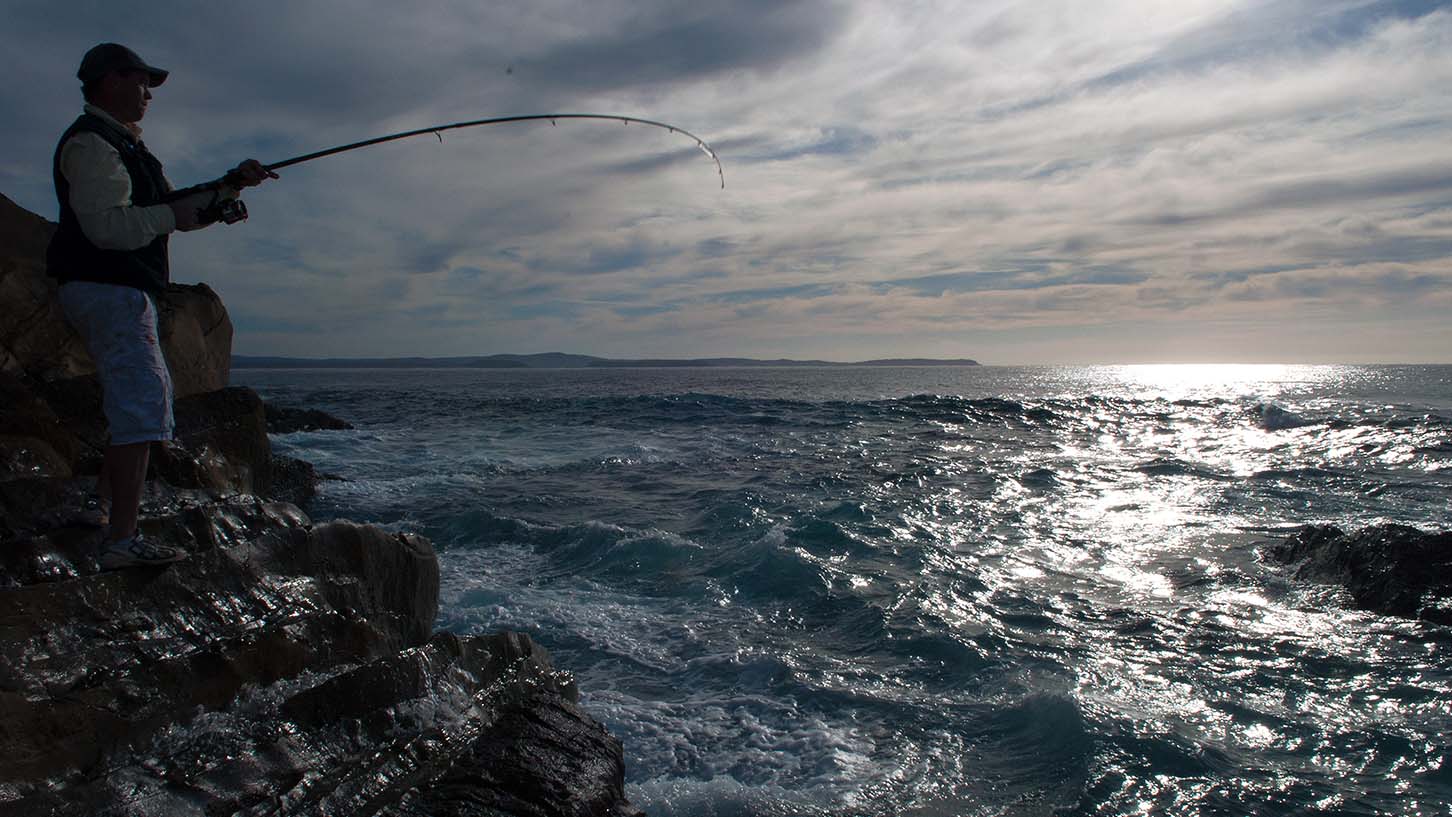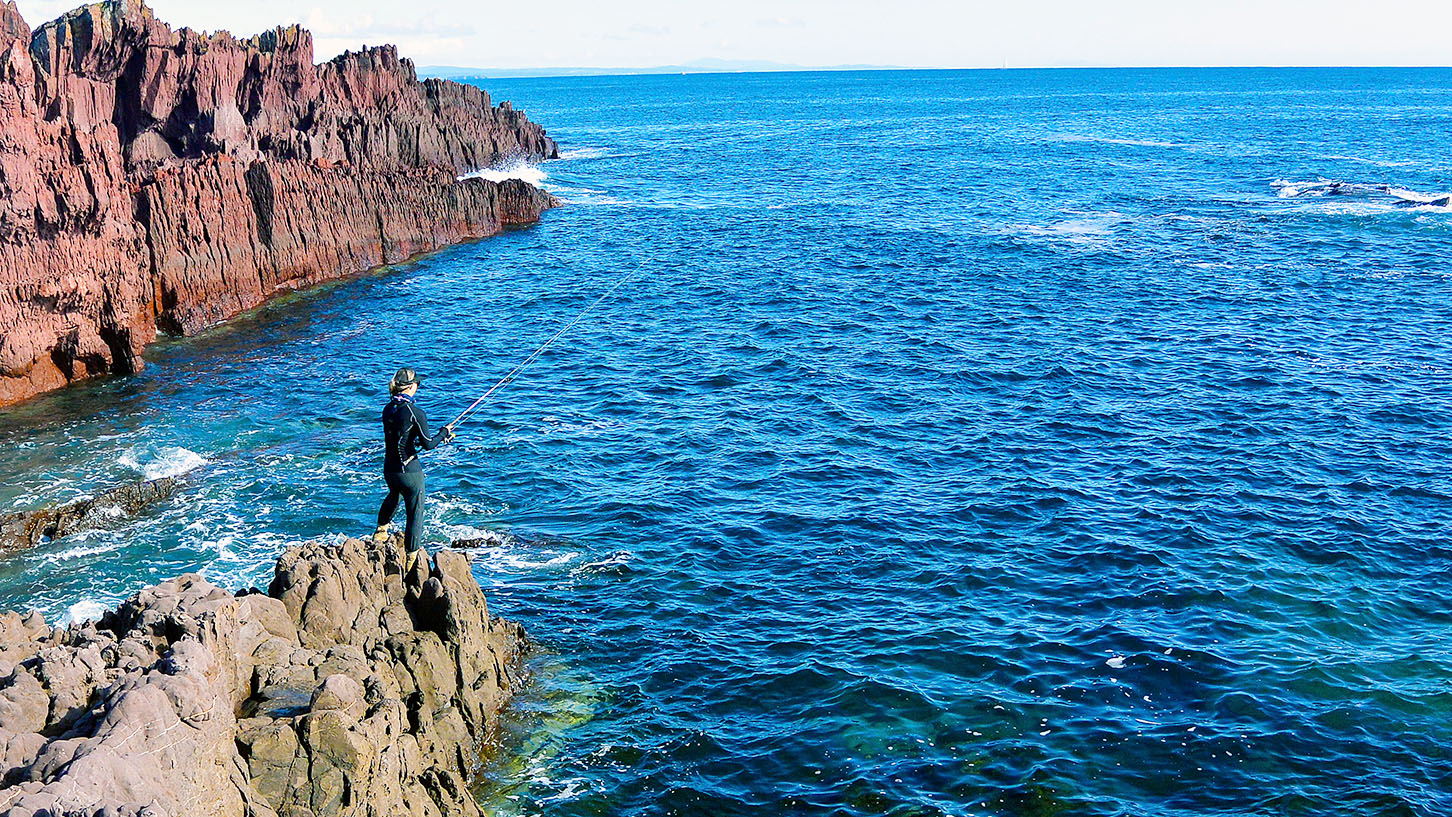| Your browser is not supported. | ||
|
Please browse our site using any of the following options:
| ||
The secret to finessing your rock fishing game

Rock fishing is special, and by going a little lighter with your gear and rigs, you'll not only lift your strike rate, but also dramatically increase the all-important fun factor! Steve Starling explains.
The single biggest mistake I see surf casters making is burdening themselves with overly heavy gear for the task at hand. By doing so, they reduce both their catch rate and their enjoyment of the sport. Some readers may be surprised to learn that I apply exactly the same principles to my rock fishing.
In my opinion, many rock hoppers also choose gear that's far too heavy, especially when chasing the core "bread and butter" winter species: fish such as bream, drummer, blackfish (luderick), sweep, leatherjackets, trevally, salmon, tailor and bonito. These fish typically range in weight from a few hundred grams to a couple of kilos, and although most are great fighters, you don't necessarily need heavy tackle to handle them. Sure, we all dream about hooking into a snapper, a mulloway or a big kingfish from the rocks, but the reality is that these larger prizes are relatively few and far between, and mostly fall to specialist anglers. If you're out to have some fun and simply catch a feed from the ocean rocks, you don't always need to be loaded for bear! By going a little lighter with your tackle, I can just about guarantee that you'll hook more fish and have a heap more fun while you're doing it.
It's all in the tackle

At first glance, the concept of "finesse" might not seem to sit so well in the more rugged realm of rock fishing. Our ocean rock ledges lie at the dramatic interface between two worlds. They're tough, wild places: ceaselessly pounded by swells, whipped by winds and eroded by exposure to salt-laden air. The creatures populating this harsh environment reflect its rigors. Armour-plated crabs, tightly clinging shellfish with heavy cases, sharp-spined urchins, leathery sea squirts and muscular, thick-scaled fish dominate our inshore coastal washes.
Traditionally, Aussie rock hoppers have matched their tackle and mind-set to this rugged environment, sandwiched precariously between the sea and the land. For decades, robust rods, thick lines, sturdy hooks and big sinkers were their weapons of choice. But there have always been significant exceptions, especially folks like the East Coast luderick or blackfish specialists. These hardy souls in their plastic sandals, tattered shorts, shoulder bags and faded spray jackets catch more fish than just about any other group of land-based fishers, yet they do it while using deceptively flimsy gear. Long, willowy rods, light lines, simple centrepin or sidecast reels, stemmed floats, split shot and tiny hooks are their tools of the trade. Blackfishing hopefuls who fail to embrace these important finesse concepts are more often than not cursed with empty keeper nets.
Elsewhere on the rocks, an acceptance of the benefits of fishing lighter, finer, longer and smarter has also gradually crept into the macho world of the rockhopper. This need for increased sophistication is most often hammered home by falling catch rates as all the easy or "dumb" fish are weeded out by the heavy tackle brigade, especially close to major population centres. For better or worse, the days of optimistically venturing forth with hawser-like lines, telephone pole rods, crane hooks and anvil-sized sinkers have largely been relegated to the pages of history. While it may be the last bastion of the skull-dragging mentality, even "bread and butter" rock fishing is slowly yielding to the concept of finesse. It's a shift driven by necessity rather than fashion.
The fine line

It'd be fair to say that "finesse" has become my core fishing philosophy over the years. I truly believe its intelligent application is capable of improving the strike rate of every angler in every scenario, whether they chase pan-sized trout in alpine streams or hefty tuna and billfish beyond the continental shelf. Rock fishing is no exception.
When bait fishing from the rocks for a whole host of temperate and cool water species, finesse is mostly about keeping sinker weights as light as practical, so that baits descend slowly, wash around, or suspend in the water column, rather than plunging to the seabed and being anchored firmly in one spot. This becomes especially important when using berley to attract fish.
Berley trails tends to bring target fish up into mid-water. Presenting your baits underneath this activity level not only risks missing those desirable targets but is also more likely to produce an endless stream of nuisance fish such as kelpies, cale, cockies, wirrahs, wrasse, green eels, rock cod and the like, not to mention way too many snags!
Dispensing with a sinker altogether or using a float rig to suspend baits and give a visual indication of bites, are simply further extensions of this finesse concept.
Logically enough, it's much easier to reduce sinker weight if you reduce the diameter of your line and leader. Finer lines are also less affected by wave and wind action and transmit bites more efficiently. As a huge bonus, skinny lines and leaders are much less obvious to shy, fickle or hard-pressured fish: something that becomes paramount on clear, bright and calm days, when rock fishing can be notoriously tough.
Fishing tackle - finding the balance
Naturally enough, the lighter you go in your tackle choices when rock fishing, the more likely it is that you'll start to lose a few good fish. This becomes especially relevant when dealing with so-called "dirty" fighters like drummer and groper. These opponents are notorious for power-diving straight for their favourite cave or undercut the instant they feel the sting of a hook, dragging your delicate line across encrusted rocks and kelp stems in the process.
Hooking a pugnacious black drummer (rock blackfish) weighing a couple of kilos on four kilo line and a long, whippy rod is an experience never forgotten, regardless of the ultimate outcome. But I guarantee that you'll hook many more of these fish on four kilo line than you will on 14 kilo line! And, as I like to say: you've got to get them on before you can get them out!
So, while there's no doubt that the use of lighter gear increases the risk of losing fish, it also increases the number of fish you'll hook in the first place. The trick lies in walking that fine, fine line between pleasure and pain: balancing brain, brawn and cunning to hopefully rack up more wins than losses.
In this regard there are two really important lessons I've learnt while finessing the stones over the past 40 years: Firstly, many fish don't pull quite as hard nor panic as madly when hooked on slightly lighter gear, and if you're on the ball, it's sometimes possible to "lead" an opponent away from trouble before going for the doctor. Secondly, if you tie good knots, have fresh, undamaged line and leaders and know your gear really well, you can pull much harder on light tackle than most people realise...unbelievably hard, as a matter of fact!
Rock fishing rigs - lighten up!

For most of my "bread and butter" rock fishing I choose to use relatively light 3-4m rods, and I typically match these sticks up with either 2500 to 4000 size spinning reels or light, shallow-spooled Alvey sidecasts.
My main line of choice is usually in the four to six kilo breaking strain range and is most often braid, although I sometimes revert to mono on a sidecast, as it's easier on the hands and fingers. When running braid, I'll add a leader of at least a rod-length or two to the business end, consisting of 5-8kg breaking strain nylon or fluorocarbon. Only very occasionally will I step this leader up to 10 or even 12 kilos, mostly where bigger drummer or the odd groper are on the cards while bait fishing, or kings and small to middling tuna are a chance when chucking lures.
If I'm lure casting, my metal slice, baitfish profile, minnow or jig-rigged soft plastic is tied directly to the end of this long leader. When I'm bait fishing, the smallest ball, bean or bug sinker I can get away with (usually a 00 or 0 size ball) runs freely on the long leader right down to my hook, which is most often a No. 4 to 2/0 Octopus or Suicide pattern, depending on the bait I'm using and the mix of species I'm targeting. My favourite baits are things like cunjevoi flesh, crab pieces, peeled prawn tails, strips of squid that I've pounded and softened with a knife handle, pink nippers (bass yabbies) or even balls of fresh bread moulded and kneaded onto the hook.
Bigger fish obviously need to be played on this light gear, and they can't be simply hauled or dragged up the rocks against a powerful backwash. Doing so will often tear out hooks or even snap leader knots. Instead, you'll need to learn to make use of the waves to wash your catch up onto the rocks or carry a long-handled landing net to secure larger fish.
Winter and early spring are my favourite times of year for walking the rocky headlands and points with a couple of light rods and a backpack, flicking lightly weighted baits or lures into the sudsy washes. Scaling down a little in the tackle department and applying the all-important concept of finesse to this game helps transform it from a pleasant stroll along the coast into a challenging, exciting, and often action-packed angling adventure. That's a good enough reason for me to turn to the lighter side.
Find your local Anaconda store and check out our extensive range of fishing gear for your next fishing trip.